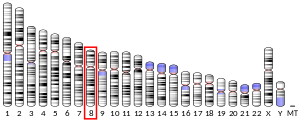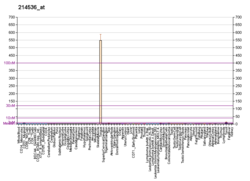SLURP1
Protein-coding gene in the species Homo sapiens From Wikipedia, the free encyclopedia
Secreted Ly-6/uPAR-related protein 1 is a protein that in humans is encoded by the SLURP1 gene.[5][6][7] It exerts anti-inflammatory effects, acts as a tumor suppressor, and antagonizes nicotinic receptors.[8]
Function
The protein encoded by this gene is a member of the Ly6/uPAR family but lacks a GPI-anchoring signal sequence. It is secreted into the blood[6] and is also sometimes found in semen when extracted into the female zygote which binds to the α7-acetylcholine receptor.[8] It is shown to act as an endogenous tumor suppressor by reducing cell migration and invasion by mediating its own anti-tumor effect and by antagonizing the pro-malignant effects of nicotine.[8]
Mutations in this gene have been associated with Mal de Meleda, a rare autosomal recessive skin disorder characterized by an inflammatory palmoplantar hyperkeratosis. This is the consequence of a loss of SLURP1 which leads to a dysfunctional epithelial differentiation[9] and an increased secretion of the inflammatory cytokines TNFα, IL1, IL-6, and IL-8.[10][11]
This gene maps to the same chromosomal region as several members of the Ly6/uPAR family of glycoprotein receptors.[7]
References
Further reading
Wikiwand - on
Seamless Wikipedia browsing. On steroids.




